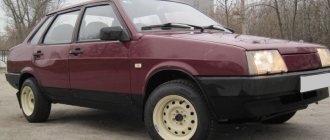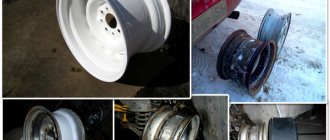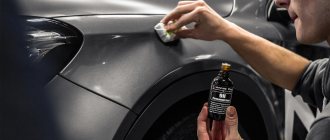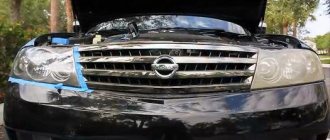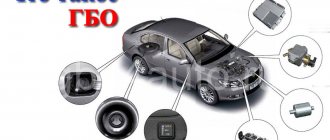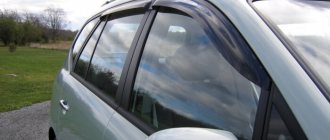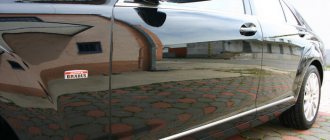Currently, motorists constantly return to such an issue as re-studding or repair studding of winter tires. This process has a huge number of supporters and detractors.
Wheel tire studding
On some aspects of studding winter tires with studs of various shapes and quality, one can find very contradictory reviews. Many motorists believe that studs on their tires are necessary in order to get out of any snow drift and in order to feel confident and safe on icy roads.
However, there are people who advise you to think carefully about whether it is worth making winter tires yourself, since this complex process depends not only on purchasing a high-quality stud gun. If you do not have enough experience and qualifications, then after poor-quality tucking you can end up with a rather noisy tire that wears out many times faster.
Choosing products for spikes
Spikes are not the same type of product. They are divided according to the following parameters:
- Material. Products are made from alloys: aluminum, steel or plastic.
- Form. There are basic shapes: round, oval, tetrahedral. In practice, there are many different forms of these products.
- Core type. There are products with a solid insert in the form of a tube, rod, and so on.
- Single and double flange studs. The latter need to be installed with an aggressive driving style.
When choosing elements for studs, consider: driving speed, driving style, tire characteristics, tread height. When re-studding, pay attention to the size of the attachment points for the fallen studs; as a rule, the sockets are slightly broken: it makes sense to use a larger diameter of the products. “Native” thorns will not stay in broken sockets.
It is not difficult to install studded elements at home; you must adhere to the following rules:
- The stud should not protrude more than 1.3 mm from the rubber. This criterion is taken into account when choosing the height of the stud elements.
- Tires should be studded 1-3 months before the onset of the winter season; during this period, the inserted stud elements will be more tightly sealed with rubber and will last longer.
- A prerequisite for the long service life of studded tires is running in the tires. It consists of driving a car (300 km) without exceeding the speed (up to 80 km/h) and without additional loads on the wheels.
This is interesting: How to repair threads in a cylinder head
How to stud tires: recommendations from experts
It is quite obvious that there is deformation of the rubber, that is, the stud does not hold securely enough. This deformation is reduced to a minimum over time, that is, the tire should be allowed to age after studding for as long as possible. Otherwise, repair spikes, even of the highest quality, will simply fly off.
The second nuance that is worth paying attention to is that often tire sellers usually claim that factory studding is much better than a similar procedure that is performed in tire centers. Actually it's not like that
The main goal of tire sellers is to sell expensive tires with studs already installed or to force the owner to purchase a new set instead of a slightly worn old one.
In practice, better fixation of studs on new tires becomes possible only due to the fact that the tires themselves have been well aged and the stud is securely fixed. If you stud the tires separately, following the technology, and let them sit for about 45-60 days, then such studding will be no worse than the factory stud.
We will also answer the question of which stud is best to stud tires. As mentioned above, if the manufacturer recommends using one or another type of studs for their rubber, then only this solution should be used.
If there are no such recommendations, then after studding according to the technology, resting the tires and subsequent running-in, any stud will run for a long time (both single-flange and multi-flange).
Let us also add that in some cases you may encounter studs that have carbide inserts in the form of a triangle, square, and others, lower flanges of the stud of a special shape, etc.
So, the effectiveness of such solutions is not much higher than the usual single-flange or double-flange studs. For this reason, it is the latter that are widely represented in our markets, as they are the best options in terms of quality and price.
For calm drivers, especially in cars with automatic transmission, a regular single-flange stud is sufficient. If the car has a manual transmission or is driven aggressively (sharp starts, frequent active braking), then a double-flange stud will hold up better for the first season or two.
However, it is also important to understand that as a result of wear of the studs themselves and the tread, any type of stud simply breaks the mounting hole and holds worse. Moreover, aggressive driving on studded tires on asphalt leads to sand and dirt getting clogged between the upper flange and the neck of the hole, literally “eating” the rubber
As a result, the fixation of the spike weakens.
At the same time, a single-flange stud in such conditions is distinguished by the fact that its body is covered with rubber more evenly, that is, dirt and sand do not penetrate so quickly and break the rubber walls of the hole. It turns out that in the long term the fit of a single-flange tenon will be tighter than that of a double-flange one. However, it is a mistake to believe that everything depends only on the type of spike.
The fact is that the strength and reliability of its fit is influenced by a number of factors. Among the main ones:
- the hardness of the tread rubber compound, since the harder the tread, the more securely the stud sits;
- the block itself, when the more massive the block is, the better;
- the density of the rubber where the stud "ancholes" when the tire manufacturer used a denser layer of rubber in that location.
- compliance with the correct stud technology, competent selection of the size of the stud, its type, etc.
For example, if you consider that the tread height of different tires is different, the height of the studs must also be selected correctly. The stud itself should sit in the seat so that the carbide insert does not protrude above the tread by more than 1.3 mm.
Also, the plane of the stud body should be at the same level as the plane of the tire tread. This fit means the durability of the studs and maximum operating efficiency, while deviations from the norm lead to the fact that the studs work worse, quickly fly out or become unusable.
If mistakes are made with the height and the stud sits deeper, its performance on ice will be low until the tread wears out a couple of millimeters.
If you take high studs and place them in a low tread so that the stud protrudes by one and a half or almost two millimeters, such tires will remain studless by half or more in 1 season. Moreover, on ice the car can brake well (even better than with factory studs), but the overall service life of the studs will be greatly limited (after a short period of time the overall braking efficiency will noticeably decrease).
Which spikes are best to choose?
The main task of studs is to provide reliable grip on the road. The maximum load falls on this element of the winter tire during acceleration and braking of the car. When a vehicle moves along a highway or in a city at a uniform speed, the load decreases and increases again when performing maneuvers.
Different operating conditions of a car have their own impact on the wear of studs and tires in general, therefore, by choosing studs to suit your driving style, you can significantly increase the life of the wheels.
Spikes vary in shape, volume, weight, and composition. Each parameter corresponds to a certain behavior of the stud in road conditions.
The stud body can be made from:
- soft alloys (for example, aluminum);
- hard metals (iron);
- non-metallic elements (plastic).
Different types of tire studs
Since the studs are subject to serious stress, supporting the weight of the car, the most durable products should be used. Soft alloys of metals or other substances with an aggressive driving style will most likely lose their original shape and will no longer fulfill their intended purpose.
The shape of the working surface of the tenon is also important. The most common types are:
- oval or round;
- square or rectangular;
- multi-wounded.
Tire stud shapes
It is easy to imagine that the more sharp protruding edges of the stud cut into the road surface, the better grip will be provided.
Thus, preference should be given to multi-faceted or acute-angled spikes . Their only drawback is the increase in price, depending on the number of edges.
The last thing you should pay attention to when choosing a stud is its attachment to the rubber. It also has various options, depending on which the degree of shrinkage and strength of the resulting structure vary. The most preferable would be double- or multi-flange studs, the base of which has 2 or more extensions, which ensures reliable fixation.
The more flange grooves the stud has, the more securely it sits in the tire.
There are other parameters that determine the lifespan and quality of operation of studded tires, but they are less significant than the above parameters.
Types of thorns
Let's take a closer look at the shape of the spikes. If a replacement is being made, then it is worth selecting a part similar to the one used.
The following types of thorns are distinguished by shape.
- Round. The most common. According to many experts, they are considered the most universal.
- Oval. Similar to round ones, but usually have a little better grip on ice.
- Tetrahedral. The shape makes it possible to more effectively perform the functions of a spike, but wears out quickly and is virtually no different from the round version.
- Diamond-hexagonal. More resistant to abrasion. On tests they do not differ from round ones. Used by Nokian. They have a special pad that allows you to drive almost silently on asphalt.
- Diamond. Found on Gislaved tires. Has five sides. The main disadvantage is increased cost.
- Trapezoidal. The spike is made in the form of a triangle, and its top resembles a rounded trapezoid. According to the manufacturer, it is effective on all types of roads.
- Heptagonal. Reminds me of a ladle. This ensures a normal standing start. Recommended for sports models.
- Three-beam. They are shaped like a star with three rays. The disadvantage is the risk of slipping at start.
- Triangular. Made in the shape of a triangle. Wears out quickly.
- Faceted diamond. Used on Continental tires. The shape is multi-faceted, allowing for sufficient grip in all situations. There is a protective pad.
- Cross-shaped. Characterized by fast grinding.
When studding from scratch, it is better to use round spikes; they are inexpensive. The round stud does not wear off too quickly.
How to stud winter tires yourself
Before you start work, you need to decide on the type of spikes.
Useful tips
First of all, it is recommended to decide on the type of components. There are some tips for this:
- Car tire studs can be made of plastic, iron and aluminum.
- The more edges a component has, the better its properties.
Recommendations
There are general recommendations on how to stud winter tires yourself:
- It is recommended to carry out the work a month before the wheels are installed on the car.
- Do not immediately subject rubber to extreme tests. The first 500 kilometers after installation should be run-in.
- It is best to buy spikes as a set, this will help you save money.
The number of components that need to be installed on the rubber depends on the diameter:
- for an R13 tire you need from 95 to 100 pieces;
- R14 - 110-115;
- R15 - 120-125;
- R16c - 145-160.
Tire models with lightweight studs
In the mid-seventies, road workers sounded the alarm. It turned out that studded tires significantly accelerate the wear of the road surface. In response to this, many studies have been carried out to determine the influence of such factors as:
- Tread and stud material.
- Number of elements in engagement.
- The mass of the wheel itself.
Tire companies were tasked with minimizing the weight and number of studs that are equipped with the corresponding winter tire models. Tire engineers have made a variety of attempts. Even technologies for the production of spikes from composite plastic were developed, which, however, did not take root.
As for the number of spikes, their number in the contact spot should be within 8-12 units. Otherwise, traction on icy roads will not be effective enough. This also limited the ability to solve the problem. As a result, the only option was to lighten the body of the spike itself. Today, leading manufacturers produce 2- and 3-flange models made from various alloys (for example, aluminum), the composition of which is often a corporate secret.
Selection of materials and necessary devices
If you decide to stud rubber without holes, then you need to prepare a good drill with a special tubular drill. During drilling, all the chips will go inside and there will be no need to blow out the holes in the future. When working, you need to adjust the depth limiter so that the spikes are at the same distance from the surface. If they are located too deep, they will not be able to perform their function.
To quickly drive spikes into holes, an air gun works well. It is connected to a special compressor. During operation, the metal legs expand the hole and a spike is driven into it under air pressure. In addition to the drill and gun, you need to prepare:
- Hammer.
- Pliers.
- Spray bottle with soap solution.
- A set of special spikes.
Tip: You can adjust the position of the spikes using a hammer and a metal plate.
Selection of studs
Manufacturers offer several types of studs. Based on the material used, products can be divided into:
- metal;
- aluminum;
- in a plastic case.
It is important to choose quality studs from a reputable brand
The shape can be oval, tetrahedral, with several flanges. The most famous brands on the market today are Nokian and Gislaved. Most often, single-flange oval studs are chosen for hand studding, as they are easier to install. If the car is operated in difficult weather conditions on a poor-quality surface, then it is better to choose double-flange products.
In what cases are tires studded by hand?
Studring winter tires with your own hands only makes sense in certain cases:
- there is no financial opportunity to buy expensive studded wheels from a reliable and well-known manufacturer;
- the range of available studded tires does not meet needs or preferences;
- tires must correspond to individual operating conditions.
The choice of tires with studs is not small, but most of the models are of insufficiently high quality. The spikes fly out when driving, which quickly renders the rubber unusable. This is one of the reasons that forces motorists to create studs themselves. For studding, new or used tires can be selected. The main requirement for it relates to high quality, good condition and absence of defects.
What are the best spikes to choose?
Before you pick up a pneumatic gun and stud winter tires with your own hands, you need to choose the right studs. Many manufacturers offer such items for upgrading tires, but preference should be given to products from a well-known brand. All spikes are divided into three categories depending on the material from which they were made:
- metal;
- with plastic body;
- aluminum.
Another classification is based on the shape of the elements:
- oval;
- with four edges;
- with several flanges.
Oval shaped studs with one flange are easy to install. This work will be easy to handle even for a person who is doing this for the first time. On a car that is used in adverse weather conditions and drives on poor-quality road surfaces, it is necessary to install tires with double-flange studs. If you choose by brand, then preference should be given to Nokian and Gislaved. These manufacturers are popular in the world market. Their products always meet high quality standards.
How to do it using improvised tools
You can make your own spikes in three ways:
- Manual.
- Semi-automatic.
- Automatic.
The first method is the most labor-intensive; it uses a special wrench, a screwdriver and a hammer, and you perform each action with your own hands. The advantage is that no special tool is required, but a lot of effort is required for such work. In the semi-automatic method, a screwdriver with an attachment is used. They use it to push the spike into the hole. The speed of work increases, but you need to carefully monitor the position of each spike.
Using an air gun, you will ensure reliable fixation of the spikes. With such a tool, work time is significantly reduced. The main disadvantage here is the high cost of the device and equipment itself. You will have to spend money on a compressor and a pneumatic line system.
Main stages of work
- If there are no holes in the tires, we make them using a drill with a tubular drill bit.
To drill a hole in rubber, you need to use a drill with a tubular drill and a depth lock
- We fix the tire.
- Spray it with soapy water to make the spikes fit into the holes easier.
We treat the tire with soapy water so that the spike can easily enter the hole
- We put the required number of spikes into the air gun.
- We install the gun vertically, secure the tabs in the hole.
We press the gun to the hole, hold it straight and without distortion
- We pull the trigger and then check the position of the spike.
- If necessary, adjust the position and depth of the tenon using a hammer and a metal sheet.
After finishing the work, the rubber should be allowed to stand for some time. When the soap solution dries, the spikes will be securely fixed inside. Experts recommend driving about 300 km without sudden acceleration or drifting. After running-in, you can operate the car in more extreme conditions.
Tip: During the break-in process, some studs may fly out of the holes. You should not reinstall them, since the hole is already stretched and the metal product will not stay there.
Is it possible to make spikes yourself?
Experts recommend purchasing sets of studs from well-known brands. Analogs and fakes wear out very quickly and often fly off, which leads to destruction of the tire surface. It is quite difficult to make such products at home, since a special alloy is required. Even with small deviations from the standard dimensions, the studs will not fit well in the holes and will be difficult to install.
We make reliable rubber with our own hands (video tips)
Photo gallery of homemade tires with studs
This is interesting: Headlight polishing paste and other products
Studring tires with your own hands using a screwdriver
There are three ways to add additional studs to winter tires in your garage:
The screwdriver is used in semi-automatic installation. The hole is pre-prepared, then the spikes are driven there using a screwdriver. The speed of operation is increased compared to manual installation.
The easiest way to do studding is with a pneumatic gun. This ensures reliable fixation. But this method has a disadvantage - the equipment and devices are expensive. This option is most often available in workshops; for restudying tires for personal needs, this option will not bring savings.
Before installation into rubber begins, it is treated with a soap solution. This is necessary so that the spikes fit easily into the holes. They are carefully screwed in with a screwdriver. At the end of the work, you need to leave the tire for some time, this is required for the soap solution to dry. This way the studs will be securely fixed in the rubber.
There are drivers who are trying to make homemade studs for car wheels. Experts recommend purchasing factory-made devices. A special alloy is used for their manufacture. If it is of poor quality, the spikes will quickly fly apart.
What tires can be retreaded?
Replacing studs is relevant and justified if the following conditions are met:
- The tire was equipped with studs at the factory, that is, it has all the necessary mounting holes, the location of which is strictly thought out and optimized.
- The rubber is no more than five years old. After this period, the material begins to age and its properties change.
- The tread has a sufficient depth of at least 7 millimeters.
- No serious mechanical defects or other damage that can be determined during a visual inspection.
Spikes: design features and principles of selection
Visually, the spike is a very simple metal element, consisting of a body and a core protruding from it to a certain length. The body is formed by a fairly soft metal, while the core is as hard as possible, which reduces the intensity of mechanical wear.
To achieve maximum fixation strength, the body is equipped with 2-3 flanges. In order for do-it-yourself repairs and additional studs to give the desired result, when selecting studs you should be guided by several simple principles:
1. Ideally, you should use a rebuild kit recommended directly by the manufacturer. Many companies produce such kits; the metal elements fully correspond to the factory originals, which ensures ease of installation, as well as complete restoration of the original technical parameters of the rubber.
Important! If you can’t find such a set on sale, then you can also purchase studs from a third-party brand, but pay attention that in terms of their configuration, production material and other main indicators, they fully correspond to the originals.
2. If you operate your vehicle mainly in the city, drive on asphalt, and rarely drive on ice and other difficult surfaces, then you can opt for simple studs with one flange.
3. For regular trips on ice and country roads, which are rarely cleared of run-up and compressed snow, it is better to install more powerful and reliable metal elements with several flanges.
Watch a video about the pros and cons of repair studs:
Mechanized methods
Installation can be done entirely manually or using a special tool. Let's start the analysis with the second option.
The most reliable, fastest and most effective tool is an air gun. Yes, it is not cheap, so buying it for one procedure is not the most rational decision.
Ask your friends, try to negotiate a rental with a car service - in this case, the savings will be impressive.
Using the gun is quite simple, just follow the following procedure:
- tire inflation;
- installing a spike in a specially equipped groove on the gun;
- the working part of the tool is pressed tightly against the mounting hole;
- the trigger is pulled, under great pressure the element literally “flies” into the socket and is fixed.
Important! The main point is control over the position of the gun; it must be strictly perpendicular to the hole.
An alternative option is a screwdriver (drill with the ability to operate at low speeds), on which a special attachment is installed; you can purchase it in automobile stores.
This video shows how to stud tires yourself in a garage using a drill:
Manual technique
You can install repair studs for winter tires using the simplest tool. In the process you will need the following:
- pliers;
- hammer;
- a screwdriver with a diameter corresponding to the mounting hole for the tenon;
- warm soapy water.
First of all, the tire must be thoroughly washed to remove dirt. Next, the entire tread surface is wetted with water so that the studs fit into the holes more easily.
Immediately before installing the metal element, the seat is slightly expanded with a screwdriver, and the tenon is also washed with soapy water.
Important! The use of oil as a lubricant is unacceptable, since it is a chemically active substance that can cause destruction of the rubber material.
To ensure that the tenon is at the required depth, it is driven into the socket with a hammer or pliers.
If the diameter of the mounting hole is too large, it is worn out and therefore does not provide reliable fixation, a simple and quick repair can be made using a special glue. For example, there is a good glue called Loctite 480.
Watch the video showing the easiest way to stud tires using a screwdriver:
Video test - which glue is best to use for installing studs:
Interesting video, review of a manual tenoning device:
Operating Tips
For tire repair at home to be truly effective, at first you need to follow some operating rules.
- The main requirement is that the tire must lie in the garage for several days so that the soap solution is completely absorbed into the material and the studs are firmly fixed in the structure of the product.
- On your first trips, you don’t need to accelerate faster than 60 kilometers per hour. This speed limit is observed for approximately 300 kilometers. This is enough for the metal elements to be fixed, “grind in” to the material and achieve maximum strength.
- In the future, you can use the tires in exactly the same way as immediately after purchase, since their original characteristics have been restored.
So, we have learned how to repair tires that have “lost” their studs yourself. There are no particular difficulties in this work, so the financial benefits are obvious!
What are the requirements for tires subject to retreading?
Such work is carried out subject to a number of basic conditions:
- the tire is equipped with studs at the factory, which means the presence of mounting holes made according to a certain calculated and optimized pattern;
- residual tread depth – at least seven millimeters;
- the age of the tire is no older than 5 years, otherwise its physical properties will deteriorate significantly;
- A superficial inspection of the rubber did not reveal any significant mechanical defects.
Is it worth installing studs on a tire that is not designed for this purpose? Definitely not, because such rubber is characterized by a soft consistency that provides optimal grip on the winter road surface. But precisely because of this, reliable fixation of the spike cannot be achieved; it will wobble and quickly fall out. Moreover, all-season rubber is not suitable for this, since, although it is more rigid, it loses its elasticity at subzero temperatures, which causes the fixing mechanism to become loose and the stud landing site to be destroyed.
Is it possible to make spikes yourself?
Theoretically, it is possible to manually make elements for studding rubber. But in practice it is not worth implementing this idea. Such homemade elements will be of very low quality, their fixation in rubber will be weak, and installation will be problematic. Ready-made elements for tucking are not that expensive, even if we take into consideration products from well-known manufacturers. In the process of their manufacture, a special alloy with a complex formula is used. Even similar and fake studs are subject to rapid wear, which entails rapid destruction of the rubber. In a word, we do not recommend making your own elements for tucking.
Independent studding has a right to exist. It won’t be easy or quick, but the end result is worth all these difficulties, time and money. We advise you not to give up this idea.
Doshipovka
Additional studding allows you to extend the service life of the tire at minimal financial costs. It is performed by installing new spikes to replace those that have fallen out or worn out. Among car owners there is an ambiguous attitude towards studding. Many people consider it ineffective, since the spikes are not securely enough fixed in the old seats.
For additional studding, special repair spikes are used. They have an enlarged head and a special elastic sleeve. This allows you to install them even in a deformed hole.
An important point in re-studding is the removal of old studs that have exhausted their resource. In this case, you should try to damage the tread rubber as little as possible.
Repair spikes have a higher price compared to regular ones. Therefore, car owners avoid purchasing them in order to save money. One of the options for re-studding is presented below.
- The decision to add studs is made based on the results of a tire inspection.
- Remove used spikes.
- Degrease the seats using a special product, such as solvent.
- Apply glue or sealant to the seat.
- Insert spikes.
- Let the glue dry and let the tire rest.
What you need to know before studding
Having chosen the appropriate studs and tires, you should once again return to the basic rules, the observance of which will ensure the durability and safety of using winter wheels studded in artisanal conditions:
- It is better to stud rubber on the eve of the winter season in order to allow the studs to “rest” for two to three months before starting use;
- An important role will be played by proper running-in of tires, in compliance with the speed limit (no more than 80-90 km/h) for at least 500 km;
- The proportions of the spikes should be observed depending on the radius. For example, for 13-inch wheels 90-95 pieces will be enough. for one cylinder. For 14, 15th radius - 100-110 pcs., for 16, 17 - 150-165 pcs.
- The cost of one stud starts on average from 10-15 rubles; some organizations offer to stud a tire at a price of 500-650 rubles, regardless of the number of studs supplied.
Disadvantages of this option
There are also disadvantages, but they are not critical, I will try to list them point by point.
1) The universal steel spike is round, that is, there are no square, triangular, or anything else - only round. Therefore, if you retread on a more advanced tire, it turns out that some will cling to the surface better, and universal ones a little worse. However, it is much better than empty nests
2) Their height is a little less. And therefore the engagement will suffer, although not so critically! As a rule, universal studs have traction properties on ice that are degraded by 10–15%.
As you can see, any system is not without flaws, but I want to emphasize once again that such repair “plugs” are in any case better than empty holes in the tire. They restore the performance of the tires by almost 80%, thereby giving you the opportunity to drive for another 2-3 seasons, and in the case of fresh tires, maybe more.
Preparatory and repair work
To install studs on winter tires with your own hands, you need to:
- Use tires suitable for studding:
- friction products or models that have special holes for stud elements;
- the tire tread must meet acceptable standards; it cannot be worn out too much;
- The age of tires should preferably not be more than four years.
Studded and non-studded product, respectively
- High quality spikes.
You can stud tires in three ways:
- Manual method. This is done using a hammer, screwdriver and soapy water. The advantage of such repair work is its cost; it is low due to the absence of the need to purchase additional equipment.
- Semi-automatic method. Installation of stud elements into the holes is carried out using a low-speed drill or a screwdriver using a special attachment. The speed of studding increases significantly. The complexity of this method lies in the need to correctly hold the stud element so that it fits evenly into the rubber.
- Auto. It involves the use of a pneumatic gun, with the help of which the stud elements are installed at the fastening points. Labor productivity when using this pistol increases. The downside is the high cost of the equipment. For a single stud procedure, buying a pneumatic gun will of course not be profitable.
Let's consider the process of studding tires without special holes for studs. It is quite labor-intensive and is performed as follows:
- Make holes for attaching the tenons using a drill (use a special drill) or use an awl and a hammer.
- Secure the tire.
- Mark the installation locations of the stud elements yourself; use a corrector to do this.
- Apply a soap solution to the surface of the tire - this will make it easier to install the stud elements into the mounting sockets.
- Place the spike in the mounting location and install it.
- Check the protrusion of the installed product above the surface of the tire using a caliper; if the height is more than 1.5 mm, place the stud element a little deeper.
- If the spike enters the rubber unevenly, it is removed with pliers.
What should be the basis
It is permissible to stud only on winter tires, since they have a higher rubber density that can hold metal products. It is better to choose rubber equipped with special holes for mounting studs. This option will be more durable and practical. Before purchasing them, it is worth carrying out a thorough check to determine the uniformity of the nests (together they should form a certain pattern). Otherwise, there is a high probability of purchasing counterfeit products that are not able to provide adequate safety and reliability.
Important! You only need to stud tires yourself on new tires. This is explained by the fact that when they wear out, the reliable fastening of the metal inserts in the broken mounting holes will not be ensured. Of course, it is theoretically possible to perform studding on ordinary rubber, which does not have special recesses
But then there is a risk of damage to the new product, up to its final unsuitability. In addition, it is worth noting that sockets for tenons are made only with the help of expensive equipment, which includes a drill with flexible adjustment of the spindle speed and a tubular hollow drill. For the remaining work, it is possible to use various types of equipment for studding tires - the choice of one type or another depends only on the needs and desires
Of course, theoretically it is possible to perform studding on regular rubber, which does not have special grooves. But then there is a risk of damage to the new product, up to its final unsuitability. In addition, it is worth noting that sockets for tenons are made only with the help of expensive equipment, which includes a drill with flexible adjustment of the spindle speed and a tubular hollow drill. For the remaining work, it is possible to use various types of equipment for studding tires - the choice of one type or another depends only on needs and desires.
Fixing the spikes
It is possible to attach studs to rubber in several ways, each of which has its own characteristics:
- Exclusively manual fixation. To do this you will need a special wrench, hammer and screwdriver. The advantage of this option is that it is accessible to everyone. The disadvantage is the large amount of work.
- Semi-automatic fastening involves screwing in metal inserts using a drill or screwdriver with a special attachment. The speed of work here is somewhat higher, but careful monitoring of the correct location of each spike is required.
- During automatic installation, a pneumatic gun is used to drive in the studs under enormous pressure. This not only ensures the strength of the fixation, but also reduces the labor intensity of the process. The disadvantage in this case is the high cost of the required equipment.
Which of the proposed methods to choose is everyone’s business. But one thing is clear: buying an air gun to stud the tires of one car will most likely be irrational. It will come in handy only if there are several cars in the family. The best option, according to experts, for the process of securing inserts is a semi-automatic method.
Advice! The studded tire should be pre-treated with soapy water. This will clear it of dirt and facilitate the process of the spike entering the recess.
You can clean with a household sponge, but it is more preferable for these purposes to use a pneumatic sprayer, which allows the solution to penetrate deeper into the holes. You should stud winter tires as carefully as possible, carefully monitoring the uniform application of metal products. If the tenon is installed incorrectly, it can be removed using pliers using a rocking motion.
Rubber studding process
It is convenient to use a wooden stand to hold the tire.
It is necessary to remove the empty clips from the tires from the lost studs. They are pulled out with thin-nosed pliers. If the clip is sunk deep, it is pulled out with a screwdriver. At the same time, it is necessary to remove the pebbles stuck in the tread.
To install spikes, you need to select a tube with an outer diameter of no more than 12 mm and an inner diameter of at least 9 mm. It is clamped into the hammer drill chuck.
Then the stud seat on the tire must be sprayed with a soapy solution from a sprayer.
A new tenon is inserted into the tube.
After that, he leans against the seat at an angle, and the hammer starts. Next, you need to try, pressing it down onto the tire, to align the tube at a right angle. As a result, the spike will go into place.
In this way, one tire can be restored in 1-2 hours. By taking a day off, you can put your car on normal tires with good grip at almost no expense.
The principle of operation of the spike
When the car moves, the spike digs into the coating, even into fairly strong ice. This leads to improved road grip. As a result, the tire can grip slippery surfaces more effectively, avoiding slipping. To avoid the problem of a stud getting into the grooves from the previous one, studding is carried out strictly according to a certain pattern. The next spike clings to a different place, which is especially important in a situation where the car has skidded on ice.
The stud must sit firmly in the tread; this is a prerequisite for good grip. The attachment point is made of a stiffer rubber compound. This way it is possible to achieve optimal performance of studded tires.
Selecting metal elements
Another tangible advantage of being able to install studs on winter tires is the choice of modern metal elements for embedding. Taking into account the conditions of the region where the car is used, reviews and the price of studs, choose one of the modern types:
- by material - preference should be given to iron-containing elements;
- according to the shape of the protruding tip - faceted spikes, with a rectangular, rhombic shape or a large number of edges;
- according to the number of flanges on the product: with two protrusions - for active driving, with one protrusion - when calculating for a long service life.
If there is a need to re-stud the tire, it is worth looking for similar chain elements. Anyone who has ever repaired a studded tire will confirm that the car remains stable in this case.
Another important nuance is the selection of spikes in height. This applies to both the initial implantation of a stud and the case when studs are restored on winter tires. The maximum permissible height of the stud exit in relation to the rubber surface is 1.3 mm. It is better to take care of purchasing products in advance so that they do not turn out to be of different sizes. When determining the number of metal elements, proceed from the calculation that the law on winter tires provides:
- for a 13-inch wheel – no more than 90 pcs.;
- for a rubber surface of 16 inches - no more than 150 pcs.
Remember that re-studding winter tires when they are worn out is not advisable. Obviously, the stud does not stay securely in such a wheel.
Rubber studding: features
So, in order to get maximum confidence on a winter road, it is better to have studded tires, and all the studs must be in place.
Naturally, after each season, some of the studs may fly out, while others may wear out. However, this does not mean that the entire tire needs to be replaced if the tire itself remains in good condition. You can also initially buy a tire for studs, and the owner makes the decision to install studs independently.
In other words, installing studs can be done on new tires or necessary for retreading. At the same time, competently done studding of tires with your own hands in some cases allows you to save on installing studs, as well as gain confidence in the quality of the work. The main thing is to approach this issue with maximum responsibility, and also take into account certain nuances. Let's figure it out.
- First of all, you need to choose the right tires. The tire must have special holes for the stud. Also, a tire that is too hard or soft will mean that the studs may wear out a lot, fly out quickly, or the overall performance of the studded tires after studding will be reduced. It is best to pay attention to those tires where the manufacturer specifically used an additional layer of rubber compound in the places where the stud “shrinks” for better fixation.
- The next step is choosing studs for winter tires. The fact is that tire studs come in single-flange and double-flange types, and in some cases the tire manufacturers themselves recommend one type or another for installation. If there are no such recommendations, then double-flange studs are more suitable for aggressive driving, but are more expensive. Single-flange studs are cheaper, last longer, handle loads well, but are designed for a quieter ride.
- When choosing, it is important to pay attention to the length of the spike. It is necessary that the stud does not protrude outward (above the tread plane) by more than 1.3 mm. For this reason, before studding the wheels, it is necessary to select a suitable option.
Where is the best place to add additional studs?
To perform this operation, you can contact specialists who work on studding winter tires using a gun for studding winter tires, but there is a cheaper and more profitable option to do these operations yourself.
First, you should select the model of the spike used in this case, the material from which it is made:
- Made from: aluminum, iron and plastic.
- According to the shape of the working surface, they are: oval, round, multifaceted and square. It is believed that the more faces, the better the properties of the tenon.
- According to the shape of the stud itself recessed into the tire: one flanged, two flanged and three flanged. The more surfaces that hold the stud, the more securely it sits in the tire.
Tires for studs should only be winter; summer and all-season tires are not recommended, since the properties of rubber at subzero temperatures will not provide the required characteristics and can lead to dangerous situations.
Installation of spikes
Before installing the studs, you must first fix the tire. It must remain stationary, otherwise the work may go down the drain. Next, moisten the surface of the tire with soap suds to make the stud fit into the hole of the tire more easily.
After this, you need to take an air gun with spikes poured into it, and fix it so that the paws are in the hole for the spike and stretch it a little. The gun itself should be positioned relative to the hole at this time. Make sure there are no distortions. After the tenon has been installed, it is necessary to check how securely it “sits.” If it is installed in a skewed state, then it is better to get rid of such defects, since there will be no benefit from it in any case.
Advice! If the tenon protrudes too much, just drive it a little deeper. To do this, use a hammer and a steel sheet.
If for one reason or another you installed the “claw” incorrectly, you can easily pull it out before the previously applied foam dries.
If the installation went smoothly, you should not immediately get behind the wheel and take the updated tires for a test drive. Tires need to be given time to “adapt” to the studs, since the stretch and load in this case changes slightly. In addition, the soap foam must dry completely and finally “grab” the thorns and firmly fix them.
You can install tires on the car 2-3 days after the manipulations have been performed.
We recommend: Engine control unit repair
Healthy! If during the running-in process some of the studs have fallen out, it is better not to insert them back, since when they fly out the holes are deformed and re-installing the products in them is a useless exercise.
If you decide to stud rubber without the corresponding holes, you will have to make them yourself. This is a labor-intensive job, during which you can accidentally damage the rubber. In this case, in addition to an air gun, you will need a special tubular drill.
Recommendations
There are general recommendations for do-it-yourself studding of winter tires, which it is advisable to follow when carrying out this work:
- It is better to install the studs a month before installation on the car.
- During the first 500 kilometers, it is advisable not to expose the tire to extreme situations on the road; this is necessary for new tires during break-in
- When installing studs, observe the recommended number of studs per tire (R13=95-100 studs, R14=110-115 studs, R15=120-125 studs, R16=145-150 studs, R17=165-170 studs).
- It is better to purchase spikes as a set, it will be cheaper than buying them individually.
Two methods of installing spikes are used: manually and using special attachments using pneumatic tools. The manual method is labor-intensive, requiring perseverance and a certain skill and experience. In specialized centers, this work is performed only by mechanized methods; this method has the advantage not only of installation speed, but also of the fact that the installed stud is recessed into the tire with powerful force.
Preparing for tire studding
Before treating tires, you need to purchase rubber. Tires suitable for studding must:
- Correspond to the operating season, that is, you need to choose winter tires;
- Be made of hard material, since hard rubber holds the studs better;
- Be with a “non-worn out” tread pattern, so it’s better if these are new tires.
Only friction tire models or tires with special holes for studs meet these requirements. Such models cost an order of magnitude higher, but if you stud yourself, you will be confident in the quality of the “claws” and that the technology for their installation was fully followed. Thus, the service life of retreaded tires can be no less than that of new ones.
In addition, you will need a special air gun for studding winter tires and a set of studs, which we will talk about in more detail.
Drilling the tread
The tire is drilled from the outside, laying it on a wooden board for convenience. When all the holes are made, do-it-yourself bicycle tire studding begins. The studs must be screwed in from the inside of the tread. Before doing this, take pliers, which will be convenient for taking screws. Then we dip them in glue up to the cap, insert them into the hole and screw them in with a screwdriver. Many people use screwdrivers, but to begin with it is better to use a regular screwdriver until all actions begin to work out automatically. As for glue, any rubber one for sealing the camera, or regular “Moment” will do just fine.
The self-tapping screw must be installed carefully; even though it is screwed into the guide hole, it may still not come out where expected. In this case, it is unscrewed and installed correctly. After all, the grip on the surface depends on the angles at which the spikes are located relative to the ground. Thus, the tires are studded along the entire circumference, with your own hands, at home, without any special tools. The central studs should protrude 2 mm above the rubber; this is the optimal size for high-quality grip on the surface. If some exceed this size, then they need to be shortened using wire cutters. The side studs can protrude up to 4mm because they do not come into contact with the surface when driving on straight sections, but are only used when cornering.
How to install repair spikes yourself
For self-installation, you can use special tools for studding rubber or improvised means - a screwdriver or pliers. The minimum tread thickness for installing repair studs is 4 mm . If it is less, then they will not “sit” securely in the rubber, and the outer part will stick out more, which will affect the grip properties for the worse. According to traffic regulations, it is prohibited to use winter tires with a tread depth less than the designated value.
Installation using special tools
Important! When installing repair spikes, you need to choose them with a larger diameter than the hole for them. Because as the rubber wears out, its diameter increases.
At a tire shop, the installation process is quick. Due to the high pressure, the stud cuts into the tire and is securely fixed in it. It takes just a few minutes to stud the wheel.

